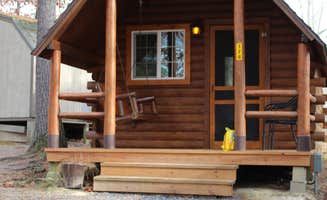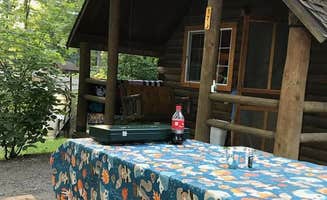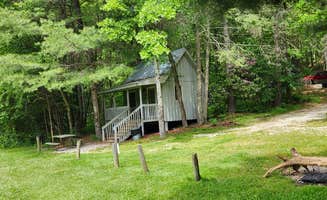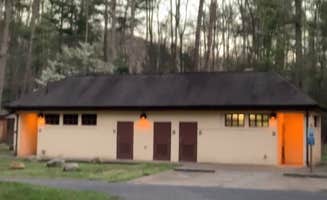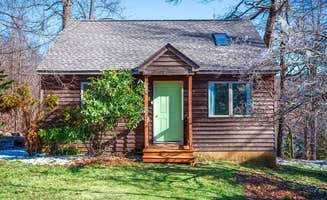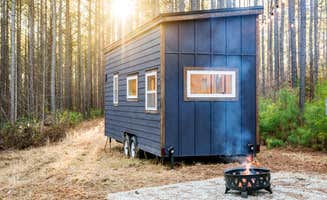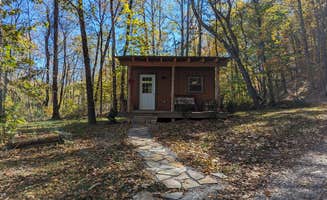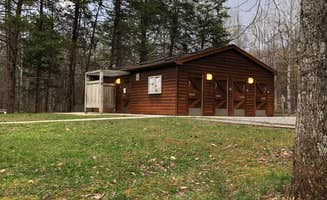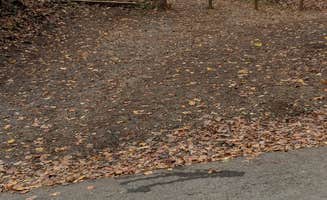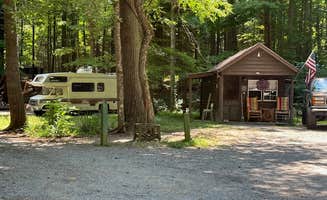Cabin camping near Glasgow, Virginia places visitors in the northern portion of the Blue Ridge Mountains where elevations range between 700-4,000 feet. Average summer temperatures reach 85°F while winter months can drop to 20°F with occasional snowfall at higher elevations. Many cabin sites sit along creek beds or forested areas where evening temperatures drop 10-15 degrees cooler than daytime readings.
What to do
Hiking nearby trails: Peaks of Otter Campground offers access to several mountain trails with varying difficulty levels. "There are tons of campsites available but they are spaced out enough to still feel secluded. Great location in relation to several popular trails. Will definitely be returning," notes one visitor. Sharp Top and Flat Top trails provide panoramic views but require proper preparation.
Water recreation: Yogi Bear's Jellystone Park provides multiple water features for cooling off during summer months. "A great place! Right next to the James River for all of your fishing needs. Have a pool, splash pad, pond/lake with a slide, beach, inflatable obstacle course," reports a camper. Fishing permits cost $8 daily at most locations with rainbow trout commonly stocked in cooler months.
Historical exploration: The Natural Bridge State Park area contains significant geological formations and historical sites. A visitor to Natural Bridge-Lexington KOA mentioned, "This KOA is one of our favorites. Open year round. Very clean showers. Close to Lexington with vineyards, restaurants and antique shops. Next door to the drive thru zoo and near Natural Bridge." History tours run daily between April-October with ticket prices starting at $9 per person.
What campers like
Private bathroom facilities: Many campers appreciate the upgraded bathroom amenities at various cabin locations. At Lynchburg / Blue Ridge Parkway KOA, a camper noted, "Best bathhouse I've encountered with something like 7 unisex bathrooms each with their own shower." These private bathroom units typically feature hot water, electrical outlets, and individual locking doors.
Scenic water features: Creekside cabin sites remain popular for their natural cooling and ambiance. A visitor to Middle Creek Campground shared, "Our campsite was nice, fairly private and backed up to a creek. Relatively level site." Many cabins offer direct creek access where water depths range from 6-24 inches during normal conditions, ideal for wading.
Seasonal activities: Many campgrounds coordinate special events throughout the camping season. One guest explained, "The campground has Halloween themed activities for kids on specific weekends. We were there for one of these weekends. It's geared for younger kids (10 and under)." Most seasonal programs run between May-October with activities posted on campground bulletin boards.
What you should know
Reservation requirements: Most cabin facilities book quickly during peak seasons. "We were only going to stay 2 nights and then move on to Nashville. Tennessee was pretty much shut down from Covid. We were glad we stayed! The campground was very nice as well as the owners and staff! They even guided you to your site and help you level," shared a visitor at Natural Bridge-Lexington KOA.
Site characteristics: Campground terrain varies significantly across the region. At Douthat State Park Campground, "White Oak Campground is larger, wooded, and has a significant elevation change between different sites. Caution should be used with large rigs as the low-water bridge to White Oak has steep approach and departure angles." Calling ahead to discuss specific site characteristics helps ensure proper placement.
Seasonal operation: Many cabin facilities operate on limited schedules. The Peaks of Otter area runs from "May 6 to October 29" while others like Lynchburg / Blue Ridge Parkway KOA operate "March 18 to November 30." Winter cabin options remain limited but Natural Bridge locations generally maintain year-round availability.
Tips for camping with families
Kid-friendly activities: Family-oriented campgrounds offer structured programming. "A great place!! Rec staff had awesome activities planned and kept the kids entertained all week with kick ball and karaoke and shaving cream wiffle ball and dance parties. Definitely worth your stay if you have kids," noted a visitor to Jellystone Park.
Swimming options: Multiple swimming areas accommodate different age groups. "The kids loved the water park! So much for them to do! There were craft nights, build an ice cream sundae night, dance parties! Giant inflatable trampolines were a blast," shared a camper. Swimming areas typically open from 10am-7pm during summer months, with some requiring reservation time slots.
Tent platforms: Some locations offer raised camping platforms ideal for family tent setups. "The tent sites were large and shaded. We were right by the fishing pond and it was a short walk to the playground, pool, jump pad, and very clean, private bathrooms. It stormed our first night, and the raised gravel tent platforms prevented us from flooding," explained a visitor at Lake Robertson.
Tips from RVers
Hookup availability: Electric and water access varies between campgrounds and specific sites. A camper at Middle Creek noted, "We had our 20 foot camper trailer and our friends stayed in cabin." Plan for 30-amp service at most locations with limited 50-amp availability at premium sites.
Site leveling: Many mountainous campgrounds require additional leveling equipment. "We had a pull-through full hookup site on the hillside. It was surprisingly very level," shared one visitor. Wooden leveling blocks and hydraulic jacks help address terrain variations common in the Blue Ridge region.
Winter preparations: For cold weather cabin camping, water systems require special attention. "We use a teardrop camper so we appreciated the water and electric hookup (although we disconnected the water at night to prevent freezing)." Temperatures frequently drop below freezing between November-March, necessitating proper winterization procedures for any external water connections.


